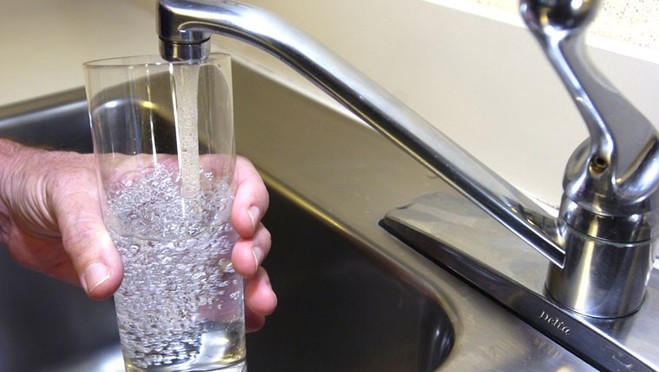 COMMENTARY – The argument has been presented that outdoor water use beautifies Davis. It is an interesting notion, but ultimately I think the argument falls short.
COMMENTARY – The argument has been presented that outdoor water use beautifies Davis. It is an interesting notion, but ultimately I think the argument falls short.
About twenty-five years ago, when I lived in San Luis Obispo and attended high school, there was a lengthy drought. The result was that most people, due to mandatory water conservation, ripped up their lawns, tore out their water-intensive gardens, and changed to less water-consuming, more drought-resistant ground cover.
Regardless of what happens with the water project, the days of wasteful water-intensive gardens are probably rapidly moving toward the past in all of California. It is simply a matter of conservation and responsibility, not only to future generations, but also to present inhabitants.
Moreover, there is no mandatory conservation here. If someone is willing to bear the increased costs of the water, they can still maintain their swimming pools and gardens. However, to expect to be able to continue wasteful water use into the future without any sort of cost is unreasonable and irresponsible.
Davis Enterprise columnist Bob Dunning disagrees. He argues, “Indoor is being billed with such terms as ‘essential,’ ‘basic’ and ‘essential to life’ … outdoor is billed as ‘wasteful,’ ‘excessive’ and basically just downright evil … which is flat out wrong …”
He writes, “Outdoor water use is what makes this town beautiful … it allows us all to enjoy the wonderful trees and flowers and lawns.”
But of course. We all enjoy those things while we acknowledge they are luxuries.
He continues, “While tearing out a lawn in favor of prickly pear cactus and river rocks is fine if you plan to sit on the porch sipping tea, kids need grass under their toes when they head outside to play in the fresh air … in a town that prides itself on being green, if this backward way of thinking prevails, it’s only a matter of time before we turn very, very brown.”
Part of being green is living within our means. The expectation that we can maintain large swaths of urban forest at low cost in an area that receives 15 to 18 inches of rain annually and would not naturally support trees and grass is not living within our means.
I am not arguing that we should not maintain our urban forest – it is what makes the summer in Davis tolerable to folks like me who do not like the heat. Rather, I think we have to be honest about our ability to continue outdoor water use.
I do not view this as an issue directly tied to the water project. No matter how we decide to deal with water into the future – whether it is surface water, conjunctive use, or deep well aquifers, we are going to need to face the prospect that we will have less water available at low cost for outdoor use.
When I lived in San Luis Obispo during the drought conditions, we took showers with a bucket to collect the run off and the startup water so we could keep the plants outside alive. Had we not received 15 inches of rain in March 1991, we would have gone to 50 percent rationing.
Even more than 20 years later, you do not find a lot of lawns in San Luis Obispo, yet I would put the aesthetic beauty of that town up against any.
This is a conversation we should have, especially as we see weather patterns changed and altered.
Mr. Dunning continues referencing a reader: “After much thought and many conversations, I suddenly realized I have not heard of a reason as to why we cannot have one flat rate for our cost of water. Why do we have to have all these complicated plans?”
Mr. Dunning believes that tiers lead to a plan that is unfair and inequitable. However, as we have noted, the actual water charts show otherwise.
He then references a member of the WAC who responded to the question as someone complained “because she was having to pay more per gallon for the water she used on a lush rose garden she heavily watered in the summer months. Why should a family of four, that is using water for basic needs, pay the same price per gallon for water this woman uses for her rose garden?”
Mr. Dunning retorts, “A great answer, but for the fact that Davis water meters don’t have two separate readings, one for ‘basic needs’ water use and the other for ‘lush rose garden.’ “
But that’s not exactly correct either. One does not need separate readings. The expanded tier proposal puts the second tier at 18 ccf per month. Last Tuesday, city staff estimated that a family of four will consume 10 ccf per month in indoor use. At 18 ccf per month, a family of 8 can be accommodated for indoor use.
That tier structure means that if you wish to have outdoor plants, you can pay the same rate up to 18 ccf of usage and if you go over that usage, you will pay slightly more for each additional gallon.
But here is the part where I think Mr. Dunning misses the mark. The tier system does not create the inequity that he argues. In fact, what all the rate models show is that the more water you use, the less you pay per gallon for that water.
Even with the tier system, the people at the lowest ends of use have the highest percentage of fixed costs, and therefore pay the most money per gallon. So when Mr. Dunning argues that we want a flat rate, he is actually calling on a system that makes the lowest-end users pay by far the highest rates.
He says he wants a fair system, but he ignores the math that shows that the system he wants is more unfair.
—David M. Greenwald reporting







“The expectation that we can maintain large swaths of urban forest at low cost in an area that receives 15 to 18 inches of rain annually and would not support naturally trees and grass is not living within our means.”
Actually that is what was here before the Europeans came.
By the way you are not in San Luis Obispo anymore. The hydrology and geography here are vastly different. As such, the romanticizing of your youth doesn’t address local realities.
In Los Angeles the answer to bathing in buckets was building an aqueduct from the Owens River to L.A. Later they added one from the Sacramento. Our proposed conveyance from the Sacramento is shorter and vastly cheaper.
“By the way you are not in San Luis Obispo anymore. The hydrology and geography here are vastly different. As such, the romanticizing of your youth doesn’t address local realities. “
That’s not an accurate comment, I’m not romanticizing about anything, I’m making a comparison in the fact that changes to water policy do not necessarily mean that we will end up with a non-beautiful community.
“This is a conversation we should have especially as we see weather patterns changed and altered.”
Weather patterns appear to suggest that more rain and less snow in the mountains is in our future. This will mean more water to recharge our aquifers and less surface water stability as the snow pack diminishes.
“When I lived in San Luis Obispo during the drought conditions, we took showers with a bucket to collect the run off and the startup water so we could keep the plants outside alive.”
Ah, those days of yesteryear, when Yolo said no to a water system that is now paid for, providing a reliable supply of water to those with the sense to participate.
David’s right, all Davis should be allowed to brown. Those that can still afford lawns or able to purchase drought tolerant plants will still have nice yards, but all of you that can’t will just have to have your kids play in the dirt. Sorry kids, but you’ll have to expect bad hops on that brown dead outfield grass on the Little League fields on F and Covell, I hope your parents have good dental insurance. Parents sitting on the sidelines at Nugget Soccer Fields had better where scarves to keep the dust from blowing in their face on windy days. Maybe the Davis High baseball team should play all road games because it will be embarrassing to have teams come to your dirt field. As david says, “this is a conversation we should have, especially as we see weather patterns changed and altered.” I know kids, you look outside and ask why this has to happen because it’s cold and rainy. But you never mind, I’m sure your teachers have taught you that too is caused by global warming.
“he is actually calling on a system that makes the lowest-end users pay by far the highest rates.”
The amount of money sucked out of our local economy is not the projected tripling of rates but rather dollars that will have to come out of home-owner budgets. A $20 water bill would add $40( probably significantly less because the higher tier rates are not included),A $100 water bill would take at least an additional $200 out of the home-owner’s discretionary spending.
No water, no tomatoes. The nuts in this town will be all that are left.
“The amount of money sucked out of our local economy is not the projected tripling of rates but rather dollars that will have to come out of home-owner budgets.”
Of course our university sucks money into our local economy at much higher rates than anything a water system could suck out.
Thanks for the idea, oxidised oracle. I’m shopping for a 5,000 gallon water truck, right now , so I can draw water out of the creek behind my place, drive 10 minutes to Davis, water a few lawns and deposit the money in the bank between trips ! The way you guys wrangle over every punctuation point, you’re sure to be buying lots of water for many purposes before you’re done insuring a “democratic” process .
It is amazing to me how the progressive mind works (or doesn’t work in some cases). If you earn more money than some, then you have more than you need. If you use more water than some, then you are using more than you need. If you use more energy than some, then you are wasting more than you should.
It must be exhausting always thinking of new problems of fairness and righteousness. You can just feel those Marxist impulses pulsating… that natural resources should be netted out in equal shares, and nobody should be allowed to acquire or use more than another.
It’s 2030 and the water police have successfully captured another fugitive and convicted him of felony filling of his pool and attempting to irrigate a small patch of grass. The DA will throw the book at him for his terrible crimes against society.
How about we stop with the business of sticking our noses into everyone else’s business? Just set a fee structure and market price, and let people figure out how they spend the money that they earn.
[i]”This will mean more water to recharge our aquifers and less surface water stability as the snow pack diminishes.”[/i]
Fortunately, we have reservoirs to even out that problem.
[i]”The expectation that we can maintain large swaths of urban forest at low cost in an area that receives 15 to 18 inches of rain annually and would not support naturally trees and grass is not living within our means.” [/i]
That’s why people settle next to rivers.
By the way, a lot of people use water to grow food.
David, I believe you are not correct about the urban forest (as in trees) not being sustainable with our normal rainfall. Lawns are another story, they would not survive without irrigation during the dry season, but trees were always in this region and do sustain themselves on the precipitation we get. Also, this area is a natural grassland, but what grows and is then dormant in the summer is not what people consider suitable for a lawn. Also, I find drought tolerant low water consuming plants very aesthetically pleasing. I do not know much about the ecological consequences of synthetic grass, but if an area is needed for kids to play that seems like a possible solution.
As for baseball, I thought that was already played on “dirt”, but soccer needs grass or something like it. Let me just put it this way, I believe if we kept the few activities that really need grass and converted everything else to something more sustainable, there would be no issues about having enough water to go around, because we have so overbuilt to sustain our current habits all these years.
dlemongello: He is wrong about the urban forest not being sustainable, and it is also possible to have lawn-like areas with considerably less water than people currently use.
I’ve collected my articles on the topic here: [url]http://redwoodbarn.com/waterconservation.html[/url]
[i]”The expanded tier proposal puts the second tier at 18 ccf per month. Last Tuesday, city staff estimated that a family of four will consume 10 ccf per month in indoor use.”
[/i]
IMO that enables people to make choices and have reasonable gardens and landscapes, and allows them to pay more if they want to make a more water-intensive yard.
David, there are a lot of aspects of your lifestyle that I might consider luxuries and wasteful. So you might wish to change your choice of adjectives. People have different priorities and value different things.
“trees were always in this region and do sustain themselves on the precipitation we get.”
I’m not an expert on the subject, but my observation is that there are natural trees only near creeks and other water ways. But perhaps that is a manifestation of the agricultural realities of today.
“David, there are a lot of aspects of your lifestyle that I might consider luxuries and wasteful. So you might wish to change your choice of adjectives. People have different priorities and value different things.”
I agree there are lots of aspects of my lifestyle (or at least there were at one point) that are luxuries and wasteful. The point I was making though is that if I’m willing to pay for those, that is fine. That does not mean that a public utility payment structure should accommodate them.
If you were walking through this area four hundred years ago, it would have been widely-spaced Valley oaks, low bunch grasses, some perennial and annual flowering plants, with riparian tree and shrub species along the creeks and sloughs, and a lot of tules (and mosquitos) closer to the Delta. Once the Spaniards came tromping through with grass seeds on their boots, the hills got covered with the taller annual grass species and annuals such as mustard that we see now.
Many other species are as adaptable as Valley oaks. Many other trees can live without supplemental irrigation once established. Many of the trees that are used as street trees can live with very little summer water once established, and most can live with less water than they get now.
Don: Thank you, I stand corrected and that alleviates my concern about the sustainability of our urban forest.
David: you hit the jackpot today for interesting articles and barrage of great comments. It’s all good.
Wait til the public sees our public utilities initiative. It will establish a routine, specific process that will promote direct democracy in our local utility planning, like Measure J/R does for urban planning and zoning.
[i]”This will mean more water to recharge our aquifers and less surface water stability as the snow pack diminishes.” [/i]
[b][i]Fortunately, we have reservoirs to even out that problem.[/i][/b]
Right now, the snow pack is in effect one huge reservoir for California. We would have to create additional reservoirs to replicate that, no?
Yes, and at least two are in the works. Sites seems most likely to go forward soonest. Temperance Flat has some hurdles. Also, I don’t think the snow pack is expected to disappear, just diminish, and recharging groundwater directly with surface supplies is another option.
Interesting, thanks.